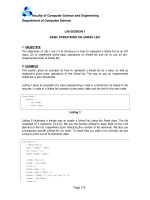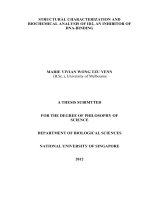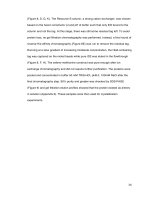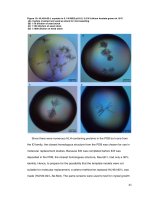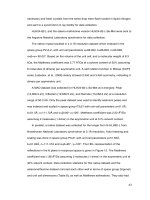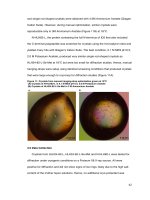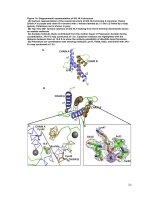Structural, magnetic and transport study of DBPLD fabricated magnetic semiconductors 1
Bạn đang xem bản rút gọn của tài liệu. Xem và tải ngay bản đầy đủ của tài liệu tại đây (1.11 MB, 65 trang )
CHAPTER 1: INTRODUCTION
CHAPTER 1
INTRODUCTION
1.1 Research Background
1.1.1 Motivation to Study Diluted Magnetic Semiconductors (DMSs)
Nowadays, almost no one can escape from computer usage, and it plays more and
more important roles in our lives. Two of the most important technologies involved in
computers are data processing and storage. In data processing, silicon integrated
circuits (ICs) are established on semiconductor materials, in which semiconductor
devices generally take advantage of the charge of electrons. In contrast, magnetic
materials are used for data storage involving the spin of electrons.
In 1996, H. Ohno first published his results of preparing a GaAs-based diluted
magnetic semiconductor by molecular beam epitaxy (MBE) [1] and proposed the
possibilities to make use of not only the charge but also the spin degree of freedom in
modern semiconductor electronics for information processing [2]. This led to a new
study field called spintronics. With the belief in the possibility of using the spin degree
of freedom of charge carriers for the design of electronic devices with new
functionalities [2, 3], spintronics has recently received considerable attention and is
developing quickly. The physical fundamentals of new generation devices combining
standard microelectronics with spin-dependent effects arise from the interaction
between spin of the carrier and magnetic ions in the material [3]. Thus, it is possible to
National University of Singapore
1
CHAPTER 1: INTRODUCTION
combine information processing and storage functionalities in one material.
Furthermore, semiconductor technology has experienced a continuous reduction in its
working dimension. Current electronic devices are getting smaller and smaller in
dimension. Spins of carriers become increasing important in the small devices because
they can provide new functionality that can be integrated into existing semiconductor
devices by combining the dissimilar properties of ferromagnetism and
semiconductivity for applications ranging from nonvolatile memory to quantum
computation. This will give rise to revolutionary change in computer technology with
increased processing speed, storage density, and even new functions.
Ferromagnetic semiconductors are anticipated to be an enabling component of the
next-generation spintronic devices [3]. The history of magnetic semiconductors began
from the late 1960’s aiming at the realization of new functionality by combining
electrical transport and magnetism. In spite of numerous studies, less practical
applications of magnetic semiconductors has been realized. Until recently, the
discovery of the carrier-mediated ferromagnetism in (In,Mn)As [4] and (Ga,Mn)As [1,
2, 5] made it possible to combine complementary properties of semiconductor
quantum structures and ferromagnetic systems in single devices. These discoveries
promoted the researches of magnetic semiconductors to fundamental materials for
spintronics.
DMSs are semiconductors which contain some magnetic ions as impurities in their
host lattices. The DMS system provides practical means to incorporate spin into
semiconductor electronics, and they are expected to pave the way for the development
National University of Singapore
2
CHAPTER 1: INTRODUCTION
of functional semiconductor spintronics [5, 6, 7, 8]. Hence,it is important for the
materials to remain semiconductive properties while magnetic ions are incorporated.
Namely, materials with peculiar combination of ferromagnetism and semiconductive
properties are required for spintronic devices. In this way, novel functionalities could
be achieved if the detection of carrier spins can be controlled optically or electrically.
Some peculiar properties of carrier induced ferromagnetism have been reported based
on these (III,Mn)V DMSs materials mentioned above. For example, a III–V
semiconductor, Mn-doped GaAs, has a Curie temperature (T
C
) about 110 K due to the
strong p–d exchange interaction by the mobile holes [2]. The magnetic element Mn has
been introduced into the nonmagnetic host-lattice of GaAs, which are widely used in
semiconductor electronics, in excess of its solubility limit by low-temperature MBE
[2]. In this homogeneous alloy, Mn occupies Ga sites and provides magnetic moments
as well as holes, which makes (Ga,Mn)As conducting. The hole-mediated
ferromagnetic interaction results in ferromagnetism.
Light-induced ferromagnetism was also reported by S. Koshihara [9]. The
structure of the inducement of a ferromagnetic order by photogenerated carriers in a
novel III-V–based magnetic semiconductor heterostructure p-(In,Mn)AsyGaSb grown
by molecular beam epitaxy is shown in Fig. 1-1(a) [9]. It is experimentally observed
that light-induced changes in Hall resistivity curves at 5 K. Before the irradiation, the
Hall resistivity changes nonlinearly with an external magnetic field with no hysteretic
behavior, as shown by the dashed line plotted in Fig. 1-1(b). After light irradiation, a
hysteresis loop develops, as shown by the solid line in Fig. 1-1(b), reflecting that the
National University of Singapore
3
CHAPTER 1: INTRODUCTION
Hall resistivity directly correlates with magnetization through the skew scattering. It
has been established that the ferromagnetic order in the p-(In,Mn)As is induced by the
presence of excess holes. Hence, it shows an experimental evidence for a
ferromagnetic order induced by photogenerated holes in this heterostructures. Based
on these results, by means of photogenerated carriers, the strength of ferromagnetic
spin exchange can be controlled by changing the hole concentrations in (In,
Mn)As/(Ga, Al)Sb heterostructures.
(a) (b)
Fig. 1-1(a) Structure of the sample. Direction of light irradiation is shown by an arrow;
(b) Hall resistivity
Hall
ρ
observed at 5 K before (dashed line) and after (solid line) light
irradiation, showing that the
Hall
ρ
correlates with magnetization directly through the
skew scattering [9].
H. Ohno et al. [10] show electric-field control of ferromagnetism in a thin-film
semiconducting alloy, using an insulating-gate field-effect transistor structure, as
shown in the insets of in Fig. 1-2. Under the condition of different gate biases which
correspond to different directions of depletion of holes, hysteresis loop in Hall
National University of Singapore
4
CHAPTER 1: INTRODUCTION
resistivity was observed to transformed from ferromagnetic to paramagnetic as a
response with the depletion of the carriers, as shown in Fig. 1-2. Besides these reports,
injection of polarized spins into the semiconductor [6, 7] have also been reported.
These features are a consequence of the controllable carrier density for the
ferromagnetic semiconductors.
Fig. 1-2 Hall resistance versus field curves under three different gate biases. The insets
show the structure of the sample, magnetic semiconductor (In, Mn)As field-effect
transistors[10].
However all these peculiar features can only be exhibited at low temperature in a
cryostat, as the highest T
C
of DMSs obtained to date is about 170 K in Ga
1-x
Mn
x
As
[11]. From the application point of view, a ferromagnetic T
C
beyond room temperature
is strongly required. The development of practical semiconductor spintronics devices
will thus require the development of new DMSs with T
C
above room temperature.
National University of Singapore
5
CHAPTER 1: INTRODUCTION
In this study field, much attention has been paid to wide band gap semiconductors,
because theoretical calculations predicted that the Tc of DMSs based on Ⅲ- (GaN) Ⅴ
and Ⅱ- (ZnO) Ⅵ compounds could be raised to above 300K [12]. Ab initio band
calculations by Sata [13] also predicted the stability of ferromagnetism (FM) in p-type
Zn
1-x
Mn
x
O, and antiferromagnetism (AF) in n-type Zn
1-x
Mn
x
O. Similar calculations
predict a FM phase for both carrier-undoped and n-type ZnO substituted with Fe, Co,
or Ni [14].
Spurred by these predictions, a large number of research groups are now working
in this field. Besides the GaN and ZnO based compounds, many kinds of materials,
including Mn doped Ⅱ- and ⅥⅢ- compounds semiconductors have been Ⅴ
extensively studied, such as Ga
1-x
Mn
x
N [15], Ga
1-x
Mn
x
As [1], (In,Mn)As [16],
Cd
1-x
Mn
x
Te [17], Zn
1-x
Mn
x
O
(M=TM) [18] and Zn
1-x
Mn
x
O [19]. Ⅱ-Ⅵ compounds
semiconductor includes a variety of compounds consisting of various combinations of
Ⅱ-group cations (such as Zn and Cd, etc.) and group- anions (such as O and Te, etc.) Ⅵ
[18-26].
During this period, several reports of high T
c
ferromagnetic DMSs appeared,
including room temperature ferromagnetism in Co-doped TiO
2
[27], ZnO based
compounds [18] , GaN based compounds [28] and SnO
2
[29]. From the physical point
of view, oxide semiconductors can be host compounds for magnetic semiconductors
since the capability of high electron doping and the rather heavy effective electron
mass for the oxide semiconductors could supply the possibility to realize high T
C
[22].
Room temperature ferromagnetic semiconductors, anatase and rutile phase Co-doped
National University of Singapore
6
CHAPTER 1: INTRODUCTION
TiO
2
were discovered with a combinatorial approach [27, 30]. Many studies have
emerged on the discovery of high T
C
ferromagnetic oxide semiconductors so far,
including ZnO based DMSs [18, 31, 32]. These reports excited the hope for the
development of practical semiconductor spintronics technologies.
Among the above mentioned oxides, ZnO based diluted magnetic semiconductors,
considered to be potential room temperature dilute magnetic semiconductors attracted
much more interesting. The first ZnO based DMS was reported by T. Fukumura,
Tokyo Institute of Technology of Japan, in which Mn-doped ZnO was fabricated as a
new class of II–VI magnetic semiconductor [22]. Some of the properties were similar
to typical magnetic semiconductors [19, 22, 33]: the absorption due to d–d transition of
the Mn ion, and the large magnetoresistance at low temperature. Moreover, the spin
glass magnetic behavior of ZnO doped with the other transition metals (TM)
synthesized with a combinatorial approach were observed [34, 35]. After that, there
have been many reports on the fabrication of transition-metal-doped ZnO. Both bulk
and thin film specimens have been synthesized. So far, Ti-, V-, Cr-, Mn-, Fe- , Co-,
Ni-doped [22, 34-41], as well as (Mn, Sn)-doped [42], (Fe, Co)-doped [43] and (Fe,
Cu)-doped [44] ZnO have been reported.
Currently, a lot of experimental and theoretical researches focused on dilute
magnetic semiconductors are based on ZnO doped with transition metal ions. Among
3d transition metals, Co-doped and Mn-doped ZnO have been commonly considered to
be ferromagnetic.
In view of dopant, Co is a good candidate dopant due to its high spin state and high
National University of Singapore
7
CHAPTER 1: INTRODUCTION
solubility limit in ZnO. Though many experimental results have been obtained on
Co-doped ZnO materials, there exist discrepancies pointed out by different groups for
the magnetic properties. The materials were deemed to be ferromagnetic [37, 45] and
nonferromagnetic [46-48].
There are many similar reports on ferromagnetic behaviors for Co doped ZnO. For
example, Ueda group [18] reported this ferromagnetic behavior, but with low
reproducibility. It was reported that Zn
1-x
(Co
0.5
Fe
0.5
)
x
O could enhance the
ferromagnetism [47]. W. Prellier et al. synthesized high-quality Co-doped ZnO thin
films using the pulsed laser deposition (PLD) technique on (0 0 0 1)-Al
2
O
3
substrates
[37]. The Zn
1-x
Co
x
O films exhibit ferromagnetism with a Curie temperature close to
room temperature for x = 0.08 and at 150K for x = 0.05. Zn
1-x
Co
x
O films with the
atomic fraction in the range 0.035–0.115 prepared by sputtering show ferromagnetic
behavior with Curie temperatures higher than 350 K [49]. Hyeon-Jun Lee et al [45]
characterized Zn
1-x
Co
x
O powder and thin films fabricated by the sol–gel process and
found that for x less than 0.25, no secondary phase was observed. The Co-doped ZnO
thin film showed ferromagnetism above 350 K [45]. Dana A. [50] demonstrated the
reversible 300K ferromagnetic ordering in a DMS, achieved in Co
2+
:ZnO.
However there were also different magnetic behaviors for Co-dope ZnO.
Sometimes, even for the compounds with similar compositions, the magnetic
behaviors were reported to be different. For example, Jae Hyun Kim et al. [36]
characterized Zn
1-x
Co
x
O (x = 0.25) films grown on sapphire (0001) substrates by
pulsed laser deposition. The homogeneous Zn
1-x
Co
x
O (x = 0.25) film show spin-glass
National University of Singapore
8
CHAPTER 1: INTRODUCTION
behavior at low temperature and high temperature Curie–Weiss behavior with a large
negative value of the Curie–Weiss temperature, indicating strong antiferromagnetic
exchange coupling between Co ions in Zn
1-x
Co
x
O. It is thought that DMS properties
will not be produced for the homogeneous bulk samples of Zn
0.9
Co
0.1
O [47].
Cobalt-doped ZnO (Zn
1-x
Co
x
O) thin films prepared by reactive magnetron cosputtering
were reported by Zhigang Yin, et al [51]. In their opinion, ferromagnetism can be
realized in Zn
1-x
Co
x
O without carrier incorporation.
As for this situation, the reports for the studies on the Co-doped ZnO materials are
considered to be controversy. Hence the origin of magnetism has been studying since
then. In this study field, studies on the sp-d exchange interactions are important. Many
results were reported to show the sp-d exchange interactions in the Co-ZnO system.
For example, Co–ZnO inhomogeneous magnetic semiconductor were synthesized
on the subnanometer scale [38]. Based on their experimental results, room temperature
ferromagnetism and large negative magnetoresistance was found at room temperature,
as shown in Fig. 1-3. It is thought that the large negative magnetoresistance may be
related to spin-dependent hopping and the magnetic-field-induced change in the
localization length.
National University of Singapore
9
CHAPTER 1: INTRODUCTION
Fig. 1-3 Dependence of sheet resistance R and the MR ratio on the magnetic field
applied measured at 4.8 K (a) and 293 K (b), respectively [38].
Similar results was reported by [35], in which combinatorial laser molecular-beam
epitaxy method was employed to fabricate epitaxial ZnO thin films doped with
Co-doped samples. After examined the magnetoresistance in laser-deposited
Zn
1-x
Co
x
O:Al (x = 0.02–0.25) thin films, the observed MR features of the samples
with different Co contents were explained in terms of the weak localization, s
–
d
exchange coupling between the conducting electrons and localized spins of magnetic
Co ions, and spin–disorder scattering [52]. K. Andoa et al. [53] reported the
observation of huge magneto-optical effects in Zn
1-x
Co
x
O films, showing a strong
mixing of the sp bands of the host ZnO with Co
2+
d orbitals, indicating that Zn
1-x
Co
x
O
National University of Singapore
10
CHAPTER 1: INTRODUCTION
is a diluted magnetic semiconductor with wide optical band.
In contrast, the ferromagnetic behaviors of Co-doped ZnO were also questioned.
For instance, S. C. Wi et al [47] studied electronic structures of homogeneous bulk
samples of Zn
0.9
Co
0.1
O using photoemission spectroscopy and x-ray absorption
spectroscopy, and considered that the DMS properties observed in Zn
1-x
Co
x
O thin
films are likely to be extrinsic. Zn
1-x
Co
x
O thin films were paramagnetic for x < 0.12
and room-temperature ferromagnetic for x > 0.12. However the ferromagnetism
originates from the nanometer-sized Co clusters.
The controversial results between research groups suggest that the ferromagnetism
strongly depends on the technical methods for the fabrication of the samples. In our
view, the possible reasons may be due to the sensitivity of properties to the
microstructures or second phases involved. Hence it is preferred to prepare the
materials under the identification conditions.
1.1.2 Fabrication Method
There exist various techniques for fabricating magnetic oxide semiconductors [54].
Due to relatively high thermal equilibrium solubility of transition metal in ZnO,
fabrication of the bulk specimen is sometimes possible. The thermal nonequilibrium
processes such as thin film growth by PLD process are usually performed. High
temperature growth sometimes leads to high crystalline quality of thin film; such a
condition may be close to the thermal equilibrium state, where the solubility of the
dopant is limited. On the other hand, low temperature processing sometimes leads to
National University of Singapore
11
CHAPTER 1: INTRODUCTION
the appearance of metastable ferromagnetic secondary phases [55-57]. Many
deposition techniques were employed, such as MBE [1, 15, 34], PLD [18, 20-23,
39,58], sputtering [49], chemical vapour deposition [59], and sol-gel method [60], ion
implantation [42], molecular beam epitaxy, and solid-state reaction. These experiments
have been plagued by highly process-dependent properties which often result in low
reproducibility. PLD has also been used to deposit nanoclusters of various sizes
[61,62].
Among the fabrication methods mentioned above, laser ablation is being widely
employed on various applications of material processing, such as thin-film deposition,
cluster formation, chemical reactions, and surface modifications (synthesis of
nanoclusters) [63]. In particular, PLD has emerged as one of the versatile techniques
for the deposition of thin films of a variety of materials such as metals, semiconductors,
and ceramic for various applications [63]. Laser-ablated plume is the source of thin
films in PLD, which primarily consists of electrons, ions, neutrals, and ionized species.
As the plume expands in an ambient medium, the ablated species from the target
undergo collisions with the atoms and molecules of the ambient medium, resulting in
scattering and slowing down of the plume. The peripheral region of the expanding
plume consists predominantly of particles of high kinetic energy; the collisional
processes are enhanced by high reactivity of the charged species that may assist in the
formation of oxides. The hydrodynamic expansion of the plume, the composition,
and size distribution of clusters depend not only on initial conditions, but also on the
laser intensity, pulse width, and ambient gas pressure. The growth and deposition of
National University of Singapore
12
CHAPTER 1: INTRODUCTION
the films are determined by the thermodynamic parameters of the target material and
initial conditions such as temperature and substrate materials.
Dual beam pulsed laser deposition (DBPLD) is a novel approach to doping
impurities in thin films [64]. It is also a suitable way to synthesize new materials [65].
In this method, two plumes are generated by laser ablation. The components including
atoms, molecules, electrons, ions and clusters from targets interact within their
overlapping plasma area. Hence, a new kind of material can be synthesized on the
substrate [65].
1.2 Objective of the Research
As mentioned above, many results of DMSs have been reported. However, in
particular, there is a great deal of controversy in the magnetic properties of the
Co-doped ZnO reported by different groups. In the case of TM-doped ZnO thin films,
some research groups claim non-ferromagnetic behaviors [22], whereas others hold
out the ferromagnetism of similar materials [18]. One reason may be due to the poor
reproducibility of processing methods. The controversial results probably originate
from different qualities of thin films fabricated by the different methods, and the
properties are micro-structural sensitive. Hence, synthesis of materials under identical
experimental conditions is helpful. Another reason is that the ferromagnetism may
even originate from metal clustering [66]. Hence, the main issues in this field include
determining the distribution of impurities and local magnetization, and the
understanding of the magnetic ordering and underlying mechanisms [67].
National University of Singapore
13
CHAPTER 1: INTRODUCTION
The fabrication of room temperature DMSs is still a great challenge. Thus,
Co-doped ZnO is one of the candidates to study.
Taking account of the above considerations, we propose to fabricate Co-doped ZnO
(Zn
1-x
Co
x
O) films by the DBPLD method. The reasons for choosing this topic are as
follows.
In the field of DMSs study, DMSs based on ZnO compound semiconductors are the
most hopeful candidate for room temperature ferromagnetic semiconductors. Co is a
good candidate dopant due to its high spin state and high solubility limit in ZnO [34].
On the other hand, DBPLD is a novel approach to dope impurities in thin films [68]. It
is also an appropriate way to synthesize new materials [65]. As it can synthesize the
films in a large range of dopant concentrations uner identical experimental conditions.
Currently, the films in a large DBPLD provides a relatively convenient way to
fabricate DMSs. By means of this method, we plan to fabricate room temperature
DMSs. We will study the stoichiometry and structure dependence properties on
processing parameters, and try to reach an available stoichiometry range. We will
investigate the underlying magnetic mechanisms. This research is under the project
entitled “Magnetic Semiconductor for Spintronics Materials” with the project code of
DSI/03-200001, which was financially supported by A*STAR (Agency for Science,
Technology and Research) of Singapore. The objectives of this project are summarized
as follows:
(1) DBPLD deposition of Co-doped ZnO thin films
Probably synthesis of single-phase oxide DMS is a must to explore the
National University of Singapore
14
CHAPTER 1: INTRODUCTION
magnetic properties arising due to the strong sp–d exchange interaction [69].
DBPLD is a novel approach to dope impurities in thin films. There are few
successful attempts on synthesizing new materials using a method at present [65].
It is the first time that DBPLD is used to fabricate DMSs. Now that ZnO based
DMSs has not been conclusively synthesized, hence we will make use of DBPLD
to investigate systematically the influence of the controllable processing
parameters on film properties. This is our first objective.
(2) Study on the structures of Zn
1-x
Co
x
O thin films
Motivated by a desire to illuminate the physical mechanisms underlying of
magnetic behaviours in DMS, we will study the structure of the thin films, which
has a very high potential for elucidating the physics behind the magnetic
properties in Zn
1-x
Co
x
O thin films.
(3) Characterization of the magnetic and electrical properties of Zn
1-x
Co
x
O thin films
Magnetism and electricity are the most important properties for a DMS. In this
argument, we shall be concerned about the features of the magnetic and
semiconductor properties for the films. Are the films ferromagnetic or
nonferromagnetic and what is the Tc? Are they semiconducting, metallic or
insulating, and what are their transport properties? As the properties seem to be
micro-structural sensitive, the third objective of this research is to characterize
the magnetic and electrical properties of the Zn
1-x
Co
x
O thin films with different
Co concentrations prepared under identical experimental conditions. In the
meantime, some results of samples which were obtained under different
National University of Singapore
15
CHAPTER 1: INTRODUCTION
experimental conditions and different Co concentrations were also supplied.
(4) Investigation on the magnetic mechanisms
It is necessary to give our claim for the magnetic behaviours of Zn
1-x
Co
x
O thin
films. Since there is no a consensus on the origin of magnetism, it is important to
answer the question on the origin of ferromagnetism after precluding second
phases. Thus the final objective of this research is to investigate the underlying
magnetic mechanisms.
1.3 Outline of the Thesis
This thesis is organized as follows:
Chapter 1 and 2 present some auxiliary results and preliminary facts, including an
introduction to the research area, literature review and the scope of our research work.
The motivation and the related research topics are also highlighted in the chapters. In
addition, the objective of our research is given.
Chapter 3 describes the experimental procedures used in this research, including
the DBPLD experimental system set-up, samples preparations, characterisation
methods and equipments.
The DBPLD method is discussed in Chapter 4. The effect of substrate position,
growth temperature and vacuum pressure on the properties of Zn
1-x
Co
x
O thin films are
discussed, and a suggestion of an optimum experimental condition for synthesizing the
Zn
1-x
Co
x
O thin films without apparent precipitates is provided. The experimental
results showed that our attempt to dope Co into ZnO was successful.
National University of Singapore
16
CHAPTER 1: INTRODUCTION
Chapter 5 presents the results on structural characterizations, including crystal
structures, chemical state and electronic structures of the Zn
1-x
Co
x
O thin films. For our
study on the crystal structures, we employed high-resolution transmission electron
microscopy (HRTEM) to verify the existence of Co clusters in the lattice on the
nanometer scale. Investigations on chemical states and electronic structures, including
valence band photoemission spectroscopy (PES), were also used to provide indirect
and direct information on the electronic structures. From our experimental results,
DBPLD grown Zn
1-x
Co
x
O films show good crystallinity, particularly for the films with
relative low Co concentrations (x < 0.1). With increasing Co concentration x, apart
from Co atoms substituting the Zn-site in ZnO, some Co atoms locate at the center of
the octahedral site rather than at tetrahedral sites.
Chapter 6 focuses on the most important properties for a DMS; magnetic and
electrical properties. The magnetic and transport behaviours of the Zn
1-x
Co
x
O thin
films in a large range of Co concentrations were characterized by the vibrating sample
magnetometer (VSM), the alternating gradient magnetometer (AGM), the
superconducting quantum interference device (SQUID), the Hall effect measurements
and a home-made 4-point R-T (resistance dependence on temperature) system. From
our experimental results, we conclude that Zn
1-x
Co
x
O with x < 0.1 is a candidate
material with both magnetic and semiconductor properties at room temperature.
However the improvement of magnetism was limited. The transport behaviors can be
explained by a hopping mechanism. The electrical states of Co ions are suggested to be
localized.
National University of Singapore
17
CHAPTER 1: INTRODUCTION
Chapter 7 investigates the possible mechanisms of magnetism. Two self-designed
experiments were used to study the magnetic anisotropy and the correlation between
magnetism and carrier density (sp-d interaction). First, we study the role of crystalline
anisotropy by preparing the Zn
1-x
Co
x
O thin films with c-axis perpendicular and parallel
to the substrate surfaces. Second, using a hand-held UV (ultra-violet) light source in a
Hall effect measurement system and an AGM system, we compared the magnetic
behaviours (M-H loops) of the films at different carrier densities to obtain evidence to
show that the magnetism and carrier density are directly correlated. The results of an
angle dependent abnormal Hall effect experiment are also given. In view of our
experimental results, we conclude that there is no magneto-crystalline anisotropy in
Zn
1-x
Co
x
O thin films, and there is no correlation between the origin of domain and
carriers in the Zn
1-x
Co
x
O thin films. Finally, possible mechanisms for the magnetism
are proposed.
National University of Singapore
18
CHAPTER 2: LITERATURE REVIEW
CHAPTER 2
LITERATURE REVIEW
2.1 Literature Review on Applications of DMS
s
DMSs have attracted great interest as potential candidates for materials in various
applications of fabrication of new devices, which could increase processing speed and
storage density, as they are believed to add a degree of freedom of spin in
semiconductors. Ferromagnetic semiconductors have emerged as important materials
for spintronic applications [1]. Some of them are given as follows.
In recent years spin transport has attracted considerable attention as it offers a
possibility for a type of transistor [2], quantum computation and quantum logic [3,4].
A significant part of the work is concentrated on spin-polarized electronic transport
through the DMS [3,4]. Compared with the most common use of ferromagnetic
transition metals, such as Fe, Co, Ni and their alloys as the magnetic electrodes for
experiments on spin-polarized tunneling of ferromagnet/insulator/ferromagnet tunnel
junctions, Ref [5] give an example of spin-polarized transport in diluted
GaMnAs/AlAs/GaMnAs ferromagnetic semiconductor tunnel junctions. Tunneling
magnetoresistance (TMR) and related phenomena were extensively studied in
magnetic tunnel junctions due to the applications in digital storage and magnetic
sensor technology.
They are potential in providing functionality and enhanced performance in
National University of Singapore
19
CHAPTER 2: LITERATURE REVIEW
semiconducting devices, including spin-based field-effect transistors (FETs), spin
polarized lasers, light-emitting diodes (LEDs), nonvolatile magnetic semiconductor
memory, and perhaps quantum computing [1,6]. For nonvolatile memory storage
applications, ferromagnetism is used to store data for extended periods of time [7]. By
manipulating spins, rather than charge, it is anticipated that more energy-efficient
memory storage will be developed [8]. In quantum computing devices, the spin states
would be used to construct “qubits,” theoretically enabling the manipulation of huge
amounts of data [9].
DMSs offer the possibility of optical spintronic devices, such as spin light-emitting
diodes [10-14], spin-polarized solar cells [12] and magneto-optical switches[13]. Some
of them have been demonstrated by II–VI and III–V DMSs as the pivotal
spin-injection components, but to date, these devices can only operate at cryogenic
temperatures because of either the absence of ferromagnetism or the low Curie
temperature Tc for the ferromagnetic phase transition [3,10,14,15]
2.2 Literature Review on Predictions for DMSs
Generally, there are two kinds of theories to predict the origin of ferromagnetism in
DMSs. One is based on the first-principles approach [16-18], the another one is the
Hamiltonian model method by T. Dietl [19,20]. Despite basic differences, both
methods gave similar predictions for the ferromagnetism for some kinds of new
materials. Let’s give a general review of these issues as follows.
National University of Singapore
20
CHAPTER 2: LITERATURE REVIEW
2.2.1 Model Based on the First-Principles Approach
In this model, the possibility of ferromagnetic DMSs at room temperature was
predicted by the first principle KKR (Korringa-Kohn-Rostoker) Green’s function
method based on the local density approximation [17,21-23].
In a DMS system, the transition metal impurities not only have local moments
different from the host atoms, but they also strongly affect the moments of the
neighboring host atoms. They show a very different behavior from sp electrons since
they have a local moment which can align either parallel or anti-parallel to the host
moments. As the local density of states (DOS) of impurities strongly reflects such a
specific behavior of the local magnetic moments, the local moments of ions can be
calculated from the local DOS of the impurities. K.Sato [21] gives an example of a
study on the stability of the ferromagnetic states of DMS (Mn-doped ZnO) based on
local density approximation. According to this theory, Tc can be determined by a
competition between the ferromagnetic and antiferromagnetic interactions.
Figure 2-1 shows the total DOS and local density of d states at the Mn site in the
25% hole doped (Zn,Mn)O both for the ferromagnetic state and the anti-ferromagnetic
state [21]. In the ferromagnetic case of hole doping, some of O atoms were substituted
with N atoms, and the hybridization between 2p states of N and 3d up spin states of
Mn is wider and larger than the band width, which lead to depressing of the
hybridization between the down spin states of Mn. Hence the high spin state of Mn
2+
is
realized by the double exchange mechanism. In the anti-ferromagnetic case, the total
DOS is symmetric in the spin direction, and the Mn-d band is narrower by the super
National University of Singapore
21
CHAPTER 2: LITERATURE REVIEW
exchange mechanism. In other words, the feature of the Mn-d states stabilizes the
ferromagnetic state, and the Mn-d state is wider in the case of ferromagnetic state than
that of the anti-ferromagnetic state. It is universally thought that the carrier induced
ferromagnetism in DMS is explained by the double exchange mechanism. In Fig. 2-2
we give that total magnetic moments per transition metal atom in ZnO. It is found that
the ferromagnetic state was the ground state for Co in ZnO under the condition of
proper doping.
In these calculations, the stability of the ferromagnetic state in ZnO-, ZnS-, ZnSe-,
ZnTe-, GaAs- and GnN-based DMS is investigated systematically, and it is suggested
that V- or Cr-doped ZnO, ZrS, ZnSe and ZnTe are candidates for high-Tc
ferromagnetic DMSs. V-, Cr or Mn-doped GaAs and GaN are also candidates for
high-Tc ferromagnets. It is also shown that Fe-, Co- or Ni-doped ZnO is ferromagnetic.
In particular, their magnetic states are controlled by changing the carrier density.
National University of Singapore
22
CHAPTER 2: LITERATURE REVIEW
Fig. 2-1 Total DOS (solid line) and local density of Mn-d states (dotted line) in the
hole doped (Zn, Mn)O. Hole doping is up to 25% [21].
National University of Singapore
23
CHAPTER 2: LITERATURE REVIEW
Fig. 2-2 Chemical trend of the magnetic states for 3d transition metal atom doped ZnO.
Total magnetic moments per transition metal atom are also shown [21].
2.2.2 T. Dietl’s Model
In this model, the tendency toward ferromagnetism have been explained within a
mean-field picture in which uniform itinerant-carrier spin polarization mediates a
long-range ferromagnetic interaction between the magnetic ions with spin S [19,24].
Curie temperature can be obtained between the ferromagnetic and anti-ferromagnetic
National University of Singapore
24
CHAPTER 2: LITERATURE REVIEW
interactions. It is here assumed that there exist two spin subsystems, i.e., carrier spins
and localized spins at magnetic ions, interacting through the sp-d interaction. Having a
nonzero magnetization increases the free energy of the localized spin system, but
reduces the energy of the carrier systems via spin-splitting of the bands (no energy
gain if no carriers are present). The free energy penalty reduces as temperature (T) is
reduced, and balances with the energy gain of the carrier system at T = Tc. The
magnitude of Tc as a function of ion and hole concentrations can be explained by this
model. In terms of this, T.Dietl predicted that Tc of GaN and ZnO can be raised above
300 K if they were p-typed doped with 5% of Mn and 3.5x10
20
holes per cm
3
. We can
refer to Fig. 2-3.
Fig. 2-3 Computed values of Tc for various p-type semiconductors containing 5% of
Mn and 3.5x10
20
holes per cm
3
[19].
National University of Singapore
25
